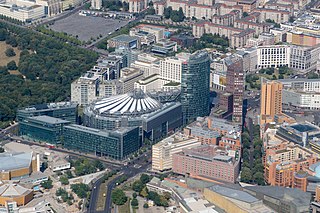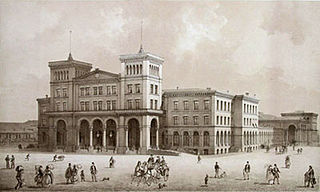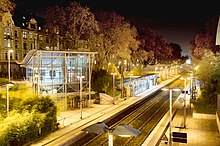
Potsdamer Platz is a public square and traffic intersection in the center of Berlin, Germany, lying about 1 km (1,100 yd) south of the Brandenburg Gate and the Reichstag, and close to the southeast corner of the Tiergarten park. It is named after the city of Potsdam, some 25 km (16 mi) to the south west, and marks the point where the old road from Potsdam passed through the city wall of Berlin at the Potsdam Gate. After developing within the space of little over a century from an intersection of rural thoroughfares into the most bustling traffic intersection in Europe, it was totally destroyed during World War II and then left desolate during the Cold War era when the Berlin Wall bisected its former location. Since German reunification, Potsdamer Platz has been the site of major redevelopment projects.

Dortmund is the third-largest city in North Rhine-Westphalia, after Cologne and Düsseldorf, and the eighth-largest city in Germany. With a population of 609,000 inhabitants, it is the largest city of the Ruhr as well as the largest city of Westphalia. It lies on the Emscher and Ruhr rivers in the Rhine-Ruhr Metropolitan Region and is considered the administrative, commercial, and cultural centre of the eastern Ruhr. Dortmund is the second-largest city in the Low German dialect area, after Hamburg.

The Hansaviertel is the smallest Ortsteil (district) of Berlin and is between Großer Tiergarten and the Spree River, within the central Mitte borough of Berlin.

U9 is a line on the Berlin U-Bahn. The line was opened on 28 August 1961 as Line G.

Friedenau is a locality (Ortsteil) within the borough (Bezirk) of Tempelhof-Schöneberg in Berlin, Germany. Relatively small by area, its population density is the highest in the city.

Friedrichshain is a quarter (Ortsteil) of the borough of Friedrichshain-Kreuzberg in Berlin, Germany. From its creation in 1920 until 2001, it was a freestanding city borough. Formerly part of East Berlin, it is adjacent to Mitte, Prenzlauer Berg, Kreuzberg and Lichtenberg.

Düsseldorf Hauptbahnhof is the main railway station of Düsseldorf, the state capital of North Rhine-Westphalia, Germany.

Görlitzer Bahnhof was the name of the Berlin railway terminus for the mainline link between the capital, Cottbus in Brandenburg and Görlitz in Lower Silesia. It stood overlooking Spreewaldplatz in the Outer Luisenstadt, the eastern part of Kreuzberg but wartime bombing and Cold War tensions led to its closure and eventual demolition.
Duisburg Hauptbahnhof is a railway station in the city of Duisburg in western Germany. It is situated at the meeting point of many important national and international railway lines in the Northwestern Ruhr valley.

Essen Hauptbahnhof is a railway station in the city of Essen in western Germany. It is situated south of the old town centre, next to the A 40 motorway. It was opened in 1862 by the Bergisch-Märkische Eisenbahn. However, the station was not the first in Essen: as the station called Essen on the Köln-Mindener Eisenbahn was opened in 1847.

Berlin Tiergarten is a railway station on the Berlin Stadtbahn line in the Tiergarten district of Berlin. It lies between the stations of Zoologischer Garten and Bellevue on the Straße des 17. Juni in the Hansaviertel locality of the Mitte borough. It opened in 1885 and is served by the S-Bahn lines S3, S5, S7 and S9 and located very close to the Großer Tiergarten park. The station is part of the Stadtbahn viaduct and has heritage listing.

Fachhochschule Dortmund - University of Applied Sciences and Arts is a university of applied sciences in Dortmund, North Rhine-Westphalia, Germany with 14,057 students, and 894 staff, 255 of which are teaching staff. It is situated in the Ruhr area, the fourth largest urban area in Europe. Fachhochschule Dortmund was created by a merger of several institutions of higher education in 1971. Owing to its history as separate institutions, it consists of three campuses in different parts of Dortmund. The Faculties of Mechanical Engineering, Electrical Engineering and Information Technology are located at Sonnenstraße near the city center. The Faculty of Design has its own campus at Max-Ophüls-Platz, while the Faculties of Applied Social Studies, Business Studies, Computer Science and Architecture are housed in several buildings next to the TU Dortmund University campus in the suburb of Eichlinghofen. The university is known for its Faculty of Business Studies. Additional offices in the city center are used for administrative purposes.

Ludwigsvorstadt-Isarvorstadt is one of the boroughs of Munich, Germany.

The North–South S-Bahn Tunnel is the central section of the North–South transversal Berlin S-Bahn connection crossing the city centre. It is not to be confused with the Tunnel Nord-Süd-Fernbahn, the central tunnel part of the North–South main line used by intercity and regional trains. The S-Bahn North–South line encompasses the route from Bornholmer Straße and Gesundbrunnen via Friedrichstraße and Anhalter Bahnhof to Papestraße and Schöneberg.

Köln-Mülheim is a railway station situated at Mülheim, Cologne in western Germany. It is served by several regional trains, the S6 and S11 lines of the Rhine-Ruhr S-Bahn and the 13 and 18 lines of Cologne Stadtbahn.

Schwerin Hauptbahnhof is the main railway station of the capital of the German state of Mecklenburg-Vorpommern and is located in the northwest of the central city. It includes four tracks on two platforms and a siding west of the fourth track. Currently the station is used by about 12,000 passengers a day.

Dortmund Stadthaus station is an important railway station of the inner city of Dortmund in the German state of North Rhine-Westphalia. It is located in the inner city at the junction of Ruhrallee (B54) and Märkischen Straße, near the Stadthaus, a municipal office building. It is classified by Deutsche Bahn as a category 5 station. The above-ground section of the station is served by Rhine-Ruhr S-Bahn line S 4 and the underground section is served by lines U41, U45, U47 and U49 of the Dortmund Stadtbahn.

Dortmund Möllerbrücke station is a transportation hub to the southwest of the inner city of Dortmund, near the Kreuzviertel (district) and West Park. A Dortmund Stadtbahn underground station is located next to the station. The station is named after the nearby Möller bridge (Möllerbrücke) and is classified by Deutsche Bahn as a category 5 station. The above ground section of the station is served by Rhine-Ruhr S-Bahn line S 4 and the underground section is served by line U42 of the Dortmund Stadtbahn. It is located on the historic Ruhr line of the Rhenish Railway Company.

Westfalenstadion is a football stadium in Dortmund, North Rhine-Westphalia, Germany, which is the home of Borussia Dortmund. Officially called Signal Iduna Park for sponsorship reasons and BVB Stadion Dortmund in UEFA competitions, the name derives from the former Prussian province of Westphalia.

The Essen Stadtbahn is a 19.6-kilometer (12.2 mi) light rail (Stadtbahn) network in Essen and the two neighbouring towns of Mülheim an der Ruhr and Gelsenkirchen in the German state of North Rhine Westphalia. It forms part of the Rhine-Ruhr Stadtbahn.





































